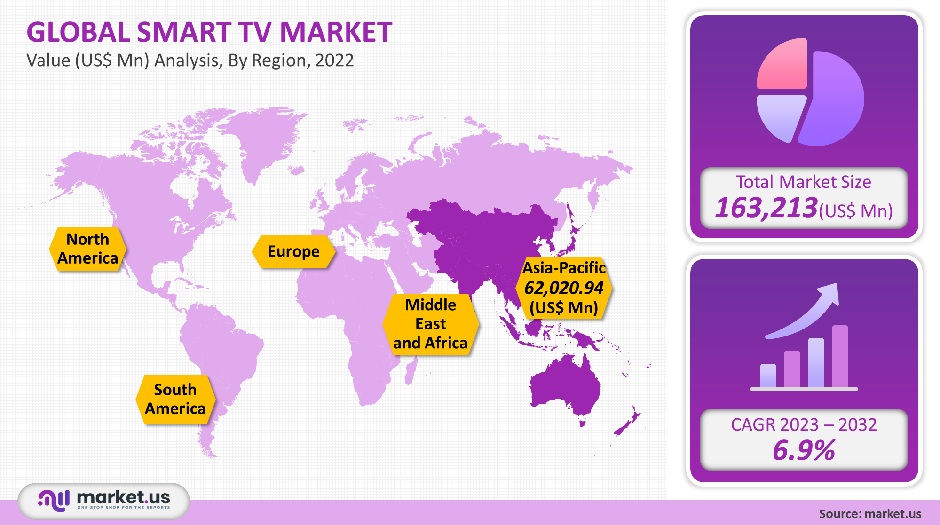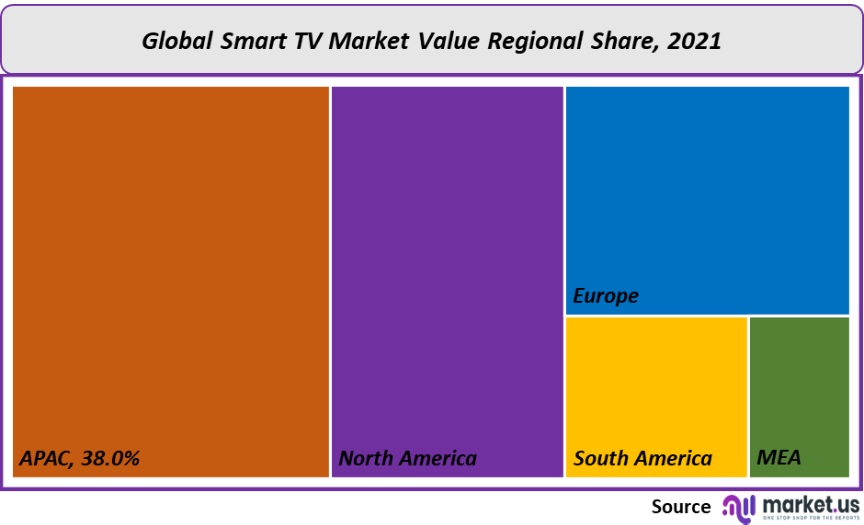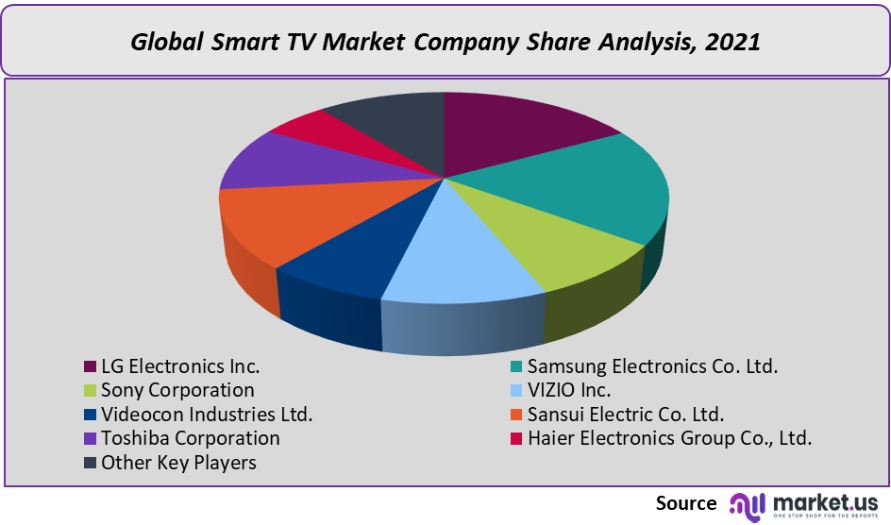Global Smart TV Market By Resolution (8K TV, HDTV, Full HD TV, and 4K UHD TV), By Screen Type (Curved, and Flat), By Screen Size (Below 32 Inches, 32 to 45 Inches, and Others), By Region and Companies - Industry Segment Outlook, Market Assessment, Competition Scenario, Trends and Forecast 2022-2032
- Published date: Nov 2021
- Report ID: 16251
- Number of Pages: 295
- Format:
- keyboard_arrow_up
Smart TV Market Overview:
The global smart TV market value was USD 163,213 million in 2021. This market is forecast to grow at a compound annual growth rate of 6.9% between 2023-2032.
Market growth is being driven by a continuous rise in streaming device use and rising internet penetration. In recent years, the shifting preferences of consumers have greatly contributed to revenue generation. The rise in demand for smart TVs is opening up lucrative opportunities to content providers who want to move into the Over the Top space (OTT), which allows them to distribute original content through the internet.
Numerous industry players are now collaborating with streaming media device manufacturers to increase their presence and expand their portfolios. All of these factors are expected to help drive market growth in the near term.
Global Smart TV Market Analysis
Resolution Analysis
Based on the resolution, there are four segments in the smart TV market: 4K UHDTV, HDTV, and Full HD TV. The 4K HDTV market accounted for around 40% of total volume and will likely continue to dominate the forecast period. Because of their continually declining prices, 4K TVs are gaining significant popularity. According to the Consumer Technology Association (CTA), 4K TVs have seen a rise in sales compared to HDTVs.
The key players, such as Sony Corporation, Samsung Electronics Co., Ltd., and LG Electronics Inc., have adopted quantum dots nanotechnology and technology to enhance the picture quality of these televisions. This has led to increasing in demand.
The 8K TV segment will experience the highest growth CAGR from 2023 to 2032. This is due in large part to the increasing demand from customers for TVs with high-resolution picture quality. An 8K TV has approximately 33 million pixels. This is significantly more than the 8 million pixels of a 4K HDTV.
Companies are increasing their 8K series portfolios and offering products with enhanced artificial intelligence capabilities to provide dynamic sound and the best picture quality. Companies are also focusing their attention on 8K TVs that have advanced features like pop-up camera, Active Voice Amplifier, Dolby Visual support in developing countries, and Dolby Acoustics. These features will ultimately help the segment grow.

Screen Type Analysis
The industry’s dominant segment, the flat-screen type, dominated in 2021. It is expected to continue its dominance in the future. Flat-panel TV sets have a lower cost than curved sets, which is why they generate high revenues. Because they are easy to mount on the wall, flat screens are preferred by most consumers. Flat screens have a higher preference due to the mirror effect caused by the curve. This is where light from the display illuminates the image.
The demand for curved screens will increase significantly. It is predicted that the CAGR for curved screens will be over 7.0% between 2023 and 2032. Curved panels allow for better viewing angles, and provide a more immersive experience.
Curved screens can also prevent video degradation from occurring when viewing off-center. Flexible TV panels can be converted from flat to curved by market vendors, creating lucrative growth prospects for this segment.
Screen Size Analysis
In 2021, the 46-55 inches segment had a significant revenue share of 38%. The increasing price of TVs and the incorporation of 4K technology into attractive features are encouraging customers to buy larger TVs. A 4K TV screen is recommended for larger TVs to enjoy better picture quality than smaller screens.
In recent years, major vendors introduced a large range of 4K televisions in response to growing customer demand. These TVs have a screen size of 55-85 inches. The market’s increasing availability will likely help expand the customer base, which in turn will contribute to the segment’s growth.
The segment with 65-inch displays is expected to see the fastest CAGR, at 15.5%, between 2023 and 2032. Many customers are planning to buy 55-inch TV sets. However, they will be willing to invest more in TV sets with 65-inch displays. The price difference between the two sets is relatively negligible. Due to rising spending power, customers are expected to spend more on next-generation large-screen television sets in the Middle East as well as the Asia Pacific.
Key Market Segments
By Resolution
- 8K TV
- HDTV
- Full HD TV
- 4K UHD TV
By Screen Type
- Curved
- Flat
By Screen Size
- Below 32 Inches
- 32 to 45 Inches
- 46 to 55 inches
- 56 to 65 Inches
- Above 65 Inches
Market Dynamics:
The smart TV industry will mature in the near future and manufacturers will be able to offer innovative products like OLEDs, QLEDs, 4K TVs, 8K TVs, and more. In addition, customers are increasingly choosing to buy these more advanced televisions because of the declining prices. In order to increase customer convenience, manufacturers are updating their products by adding new features and functions to their older models. The industry has also seen a high penetration of the 4K UHD TV segment. This resolution has been a standard for most manufacturers.
Smart TVs offer advanced features and applications that are not available on conventional televisions. The leading players in the streaming market are working to develop their own operating system to counter the intense competition from other providers such as Roku and Apple. WebOS by LG Electronics and Tizen by Samsung Electronics Co. Ltd., both allow users to download applications from their store and also provide access to online streaming apps. New TV models include voice recognition tools that allow users to easily switch channels by speaking their words.
Android is used as an operating system by smart TV providers, making it easier for users to access major OTT platforms like Hulu, Netflix, and YouTube. Google Play also offers access to Android-based applications such as Twitter, Facebook, and Google Play. Android TVs can also be controlled by voice commands.
Magic remotes are available to access these apps. Sony One-Flick’s remote features an inbuilt microphone that allows users to use voice commands to find their favorite channels and shows. Android comes with a host of in-built apps. These include music, movies, and games.
People were restricted to their homes by strict lockdowns enforced by various government agencies since the COVID-19 epidemic. This greatly increased online video streaming and led to a significant increase in smart TV sales. The pandemic caused a temporary suspension of manufacturing operations, which resulted in a significant slowdown in production.
However, this has not been good news for the consumer electronics sector. To maximize profits, market players have been focusing their efforts on reducing operating expenses. Samsung Electronics Co. Ltd. as well as LG Electronics Inc. were forced to suspend their production in Europe and Asia Pacific countries. This had a profound impact on the production of new TVs. The pandemic has also had an impact on consumer buying behavior. They are spending more on essential goods than on luxury items. This has limited market growth.
Regional Analysis
The Asia Pacific held the largest market share of 38%, in 2021. This region is expected to continue dominating the forecast period. This region will also experience the fastest growth, from 2023 through 2032. The growth of the region’s market is greatly influenced by the increasing use of smart televisions in developing countries like India. In the region, there will be a growing demand for 4K display technology because of consumer preference for better picture quality and sleeker design. This is projected to increase revenue generation opportunities.
China holds a large portion of the regional market. However, new players such as TCL Corporation, Hisense Co., Ltd., have made their presence felt and are making it more difficult for larger players.
The Middle East region and Africa are expected to see significant growth, with an estimated CAGR of more than 12% between 2023-2032. A rapid increase in smart TV usage in the region is due to advances in the OTT sector and a significant increase in the production of engaging content. Product demand is also being influenced by shifting consumer focus to online content due to increasing access to high-speed, seamless internet.

Key Regions and Countries covered іn thе rероrt:
- North America
- US
- Canada
- Mexico
- Europe
- Germany
- UK
- France
- Italy
- Russia
- Spain
- Rest of Europe
- APAC
- China
- Japan
- South Korea
- India
- Rest of Asia-Pacific
- South America
- Brazil
- Argentina
- Rest of South America
- MEA
- GCC
- South Africa
- Israel
- Rest of MEA
Market Share & Key Players Analysis:
It is fairly fragmented with no dominant player. However, the market has experienced significant growth in the last few years and continues offering lucrative growth opportunities to participants. Despite the fact that the supply chain was severely affected by the COVID-19 pandemic, in the beginning, companies are making great efforts to get their operations back on track.
To gain a competitive edge, market players use a variety of strategies to increase their market share. Samsung Electronics Co. These devices have achieved an outstanding energy efficiency rating. Sony Corporation announced pricing and availability for its LED and OLED models that include Google Assistant. This allows users to easily access entertainment and device controls.

Маrkеt Кеу Рlауеrѕ:
- LG Electronics Inc.
- Samsung Electronics Co. Ltd.
- Sony Corporation
- VIZIO Inc.
- Videocon Industries Ltd.
- Sansui Electric Co. Ltd.
- Toshiba Corporation
- Haier Electronics Group Co., Ltd.
- Other Key Players
For the Smart TV Market research study, the following years have been considered to estimate the market size:
Attribute Report Details Historical Years
2016-2020
Base Year
2021
Estimated Year
2022
Short Term Projection Year
2028
Projected Year
2023
Long Term Projection Year
2032
Report Coverage
Competitive Landscape, Revenue analysis, Company Share Analysis, Manufacturers Analysis, Volume by Manufacturers, Key Segments, Key company analysis, Market Trends, Distribution Channel, Market Dynamics, COVID-19 Impact Analysis, strategy for existing players to grab maximum market share, and more.
Regional Scope
North America, Europe, Asia-Pacific, South America, Middle East & Africa
Country Scope
United States, Canada and Mexico, Germany, France, UK, Russia and Italy, China, Japan, Korea, India and Southeast Asia, Brazil, Argentina, Colombia etc.Saudi Arabia, UAE, Egypt, Nigeria and South Africa
Frequently Asked Questions (FAQ)
Q: What is the Smart TV market size in 2021?A: The Smart TV market size is US$ 163,213 million for 2021.
Q: What is the CAGR for the Smart TV market?A: The Smart TV market is expected to grow at a CAGR of 6.9% during 2023-2032.
Q: What are the segments covered in the Smart TV market report?A: Market.US has segmented the Global Smart TV Market Value (US$ Mn) Analysis by Region, 2022 market by geographic (North America, Europe, APAC, South America, and Middle East and Africa). By Resolution, market has been segmented into 4K UHD TV, Full HDTV, 8K TV, HDTV. By Screen size, the market has been further divided into Below 32 Inches, 32 to 45 Inches, 46 to 55 inches, 56 to 65 Inches, Above 65 Inches. By Screen type, the market has been further divided into curved and flat.
Q: Who are the key players in the Smart TV market?A: LG Electronics Inc., Samsung Electronics Co. Ltd., Sony Corporation, VIZIO Inc., Videocon Industries Ltd., Sansui Electric Co. Ltd., Toshiba Corporation, Haier Electronics Group Co. Ltd., and Other Key Players are the key vendors in the Smart TV market.
Q: Which region is more attractive for vendors in the Smart TV market?A: APAC accounted for the highest revenue share of 38% among the other regions. Therefore, the Smart TV market in APAC is expected to garner significant business opportunities for the vendors during the forecast period.
Q: What are the key markets for Smart TV?A: Key markets for Smart TV are US, China, Japan, India, Brazil, Germany, UK, France, Italy, Spain, etc.
Q: Which segment has the largest share in the Smart TV market?A: In the Smart TV market, vendors should focus on grabbing business opportunities from the flat screen type segment as it accounted for the largest market share in the base year.
![Smart TV Market Smart TV Market]()
- LG Electronics Inc.
- Samsung Electronics Co. Ltd.
- Sony Corporation
- VIZIO Inc.
- Videocon Industries Ltd.
- Sansui Electric Co. Ltd.
- Toshiba Corporation Company Profile
- Haier Electronics Group Co., Ltd.
- Other Key Players
- settingsSettings
Our Clients
|
Single User
$5,999
$2,999
USD / per unit
save 50% |
Multi User
$7,999
$3,499
USD / per unit
save 55% |
Corporate User
$12,999
$4,499
USD / per unit
save 65% | |
|---|---|---|---|
| e-Access | |||
| Data Set (Excel) | |||
| Company Profile Library Access | |||
| Interactive Dashboard | |||
| Free Custumization | No | up to 10 hrs work | up to 30 hrs work |
| Accessibility | 1 User | 2-5 User | Unlimited |
| Analyst Support | up to 20 hrs | up to 40 hrs | up to 50 hrs |
| Benefit | Up to 20% off on next purchase | Up to 25% off on next purchase | Up to 30% off on next purchase |
| Buy Now ($ 2,999) | Buy Now ($ 3,499) | Buy Now ($ 4,499) |









